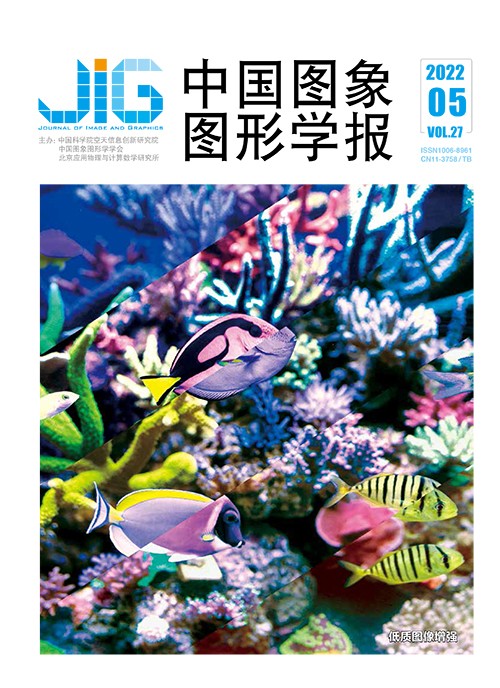
改进融合策略下透明度引导的逆光图像增强
摘 要
目的 针对传统的逆光图像增强算法存在的曝光正常区域与逆光区域间阈值计算复杂、分割精度不足、过度曝光以及增强不足等问题,提出一种改进融合策略下透明度引导的逆光图像增强算法。方法 对逆光图像在HSV(hue, saturation, value)空间中的亮度分量进行亮度提升和对比度增强,然后通过金字塔融合策略对改进的亮度分量进行分解和重构,恢复逆光区域的细节和颜色信息。此外,利用深度抠图网络计算透明度蒙版,对增强的逆光区域与源图像进行融合处理,维持非逆光区域亮度不变。通过改进融合策略增强的图像在透明度引导下既有效恢复了逆光区域又避免了曝光过度的问题。结果 实验在多幅逆光图像上与直方图均衡算法、MSR (multi-scale Retinex)、Zero-DEC (zero-reference deep curve estimation)、AGLLNet (attention guided low-light image enhancement) 和LBR (learning-based restoration) 5种方法进行了比较,在信息熵(information entropy,IE)和盲图像质量指标(blind image quality indicators,BIQI)上,比AGLLNet分别提高了1.9%和10.2%;在自然图像质量评价(natural image quality evaluation,NIQE)方面,比Zero-DCE(zero-reference deep curve estimation)提高了3.5%。从主观评估上看,本文算法增强的图像在亮度、对比度、颜色及细节上恢复得更加自然,达到了较好的视觉效果。结论 本文方法通过结合金字塔融合技术与抠图技术,解决了其他方法存在的色彩失真和曝光过度问题,具有更好的增强效果。
关键词
An improved fusion strategy based on transparency-guided backlit image enhancement
Zhao Minghua1,2, Cheng Danni1, Du Shuangli1, Hu Jing1, Shi Cheng1, Shi Zhenghao1(1.School of Computer Science and Engineering, Xi'an University of Technology, Xi'an 710048, China;2.Shaanxi Key Laboratory of Network Computing and Security Technology, Xi'an 710048, China) Abstract
Objective The backlit image is a kind of redundant reflection derived of the light straightforward to the camera, resulting in dramatic reduced visibility of region of interest (ROI) in the captured image. Different from ordinary low-light images, the backlit image has a wider grayscale range due to the extremely dark and bright parts. Traditional enhancement algorithms restore brightness and details of backlit parts in terms of overexposure and color distortion. Fusion technology or threshold segmentation is difficult to implement sufficient enhancement or adequate segmentation accuracy due to uneven images gray distribution. A transparency-guided backlit image enhancement method is demonstrated based on an improved fusion strategy. Method The backlit image enhancing challenge is to segment and restore the backlit region, which is regarded as the foreground and the rest as the background. First, the deep image matting model like encoder-decoder network and refinement network is illustrated. The backlit image and its related trimap are input into the encoder-decoder network to get the preliminary transparency value matrix. The output is melted into the refinement network to calculate the transparency value of each pixel, which constitutes the same scale alpha matte as the original image. The range of transparency value is between 0 and 1, 0 and 1 indicates pixels in the normal exposure region and the backlit region, respectively. The value between 0 and 1 is targeted to the overlapped regions. The alpha matte can be used to substitute the traditional weight map for subsequent fusion processing in terms of processed non-zero pixels. Next, the backlit image is converted into HSV(hue, saturation, value) space to extract the luminance component and the adaptive logarithmic transformation is conducted to enhance brightness in terms of the base value obtained from the number of low-gray image pixels. Contrast-limited adaptive histogram equalization is also adopted to enhance the contrast of the luminance component while logarithmic transformation can only be stretched or compressed gray values. Subsequently, Laplacian pyramid fusion is illustrated on the two improved luminance components. The obtained result was integrated into the original hue component and saturation component and it is converted to RGB space to obtain the global enhanced image. Finally, the alpha matte is used to linearly fuse the source image and the global enhanced image to maintain the brightness of non-backlit area. Result Our demonstration is compared to existing methods, including histogram equalization (HE), multi-scale Retinex (MSR), zero-reference deep curve estimation(Zero-DCE), attention guided low-light image enhancement(AGLLNet) and learning-based restoration (LBR). Information entropy (IE), blind image quality indicator (BIQI) and natural image quality evaluation (NIQE) are utilized to evaluate the restored image quality. IE is used to measure the richness of image information. The larger the value is, the richer the information and the higher the image quality are. BIQI performs distortion recognition is based on the calculated degradation rate of the image, and a small value represents a high quality image. NIQE compares the image with the designed natural image model, and the lower the value is, the higher the image sharpness is. Both subjective visual effects and objective image quality evaluation indicators are analyzed further. Our qualitatiave analysis can demonstrate better backlit image, no artifacts and natural visual effect, while HE causes color distortion and serious halo phenomenon in non-backlit region. MSR processes the three color channels each to cause the color information loss, Zero-DCE lacks color saturation and the enhancement effect of AGLLNet is not clarified. LBR is limited to segmentation accuracy, leading to color distortion and edge artifacts. Our quantitative algorithm illustrates its priorities in IE, BIQI and NIQE, improving by 0.137 and 3.153 compared with AGLLNet in IE and BIQI, respectively, and 3.5% in NIQE compared with Zero-DCE. Conclusion We introduced the deep image matting with precise segmentation capability to detect and identify the backlit region. An enhanced image brightness component is obtained via the improved Laplacian pyramid based fusion strategy. Our demonstration improves the brightness and contrast of the backlit image and restores the details and color information. The over-exposure and insufficient enhancement can be resolved further. Artifacts and distortion issues are not involved in our algorithm,and the improvement of objective quality evaluation index validates the backlight image enhancement.
Keywords
|



 中国图象图形学报 │ 京ICP备05080539号-4 │ 本系统由
中国图象图形学报 │ 京ICP备05080539号-4 │ 本系统由